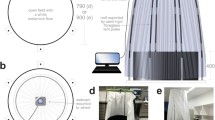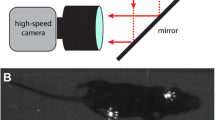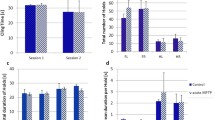Abstract
In current research with laboratory animals, observing their dynamic behavior or locomotion is a laborintensive task. Automatic continuous monitoring can provide quantitative data on each animal’s condition and coordination ability. The objective of the present work is to develop an automated mouse observation system integrated with a conventional open-field test for motor function evaluation. Data were acquired from 86 mice having a targeted disruption of the arylsulphatase A (ASA) gene and having lowered coordinated locomotion abilities as a symptom. The mice used were 36 heterozygotes (12 females) and 50 knockout mice (30 females) at the age of 6 months. The mice were placed one at a time into the test setup, which consisted of a Plexiglas cage (53× 34.5 × 26 cm) and two fluorescent bulbs for proper illumination. The transparent cage allowed images to be captured from underneath the cage, so image information could be obtained about the dynamic variation of the positions of the limbs of the mice for gait reconstruction. Every mouse was recorded for 10 min. Background subtraction and color filtering were used to measure and calculate image features, which are variables that contain crucial information, such as the mouse’s position, orientation, body outline, and poßible locations for the mouse’s paws. A set of heuristic rules was used to prune implausible paw features and label the remaining ones as front/hind and left/right. After we had pruned the implausible paw features, the paw features that were consistent over subsequent images were matched to footprints. Finally, from the measured footprint sequence, eight parameters were calculated in order to quantify the gait of the mouse. This automatic observation technique can be integrated with a regular open-field test, where the trajectory and motor function of a free-moving mouse are measured simultaneously.
Similar content being viewed by others
References
Clarke, K. A., & Still, J. (2001). Development and consistency of gait in the mouse. Physiology & Behavior, 73, 159–164.
Crawley, J. N. (2003). Behavioral phenotyping of rodents. Comparative Medicine, 53, 140–146.
Crawley, J. N., & Paylor, R. (1997). A proposed test battery and constellations of specific behavioral paradigms to investigate the behavioral phenotypes of transgenic and knockout mice. Hormones & Behavior, 31, 197–211.
de Medinaceli, L., Freed, W. J., & Wyatt, R. J. (1982). An index of the functional condition of rat sciatic nerve based on measurements made from walking tracks. Experimental Neurology, 77, 634–643.
Dijkstra, J. R., Meek, M. F., Robinson, P. H., & Gramsbergen, A. (2000). Methods to evaluate functional nerve recovery in adult rats: Walking track analysis, video analysis and the withdrawal reflex. Journal of Neuroscience Methods, 96, 89–96.
Gerlai, R. (2002). Phenomics: Fiction or the future? Trends in Neurosciences, 25, 506–509.
Hamers, F. P. T., Lankhorst, A. J., van Laar, T. J., Veldhuis, W. B., & Gispen, W. H. (2001). Automated quantitative gait analysis during overground locomotion in the rat: Its application to spinal cord contusion and transection injuries. Journal of Neurotrauma, 18, 187–201.
Heß, B., Saftig, P., Hartmann, D., Coenen, R., Lüllmann-Rauch, R., Goebel, H. H., et al. (1996). Phenotype of arylsulphatase A-deficient mice: Relationship to human metachromatic leukodystrophy. Proceedings of the National Academy of Sciences, 93, 14821–14826
Johnston, R. B., Zachary, L., Dellon, A. L., Seiler, W. A., IV, & Teplica, D. M. (1991). Improved imaging of rat hindfoot prints for walking track analysis. Journal of Neuroscience Methods, 38, 111–114.
Jolicoeur, F. B., Rondeau, D. B., Hamel, E., Butterworth, R. F., & Barbeau, A. (1979). Measurement of ataxia and related neurological signs in the laboratory rat. Canadian Journal of Neurological Sciences, 6, 209–215.
Leroy, T., Silva, M., D’Hooge, R., Aerts, J.-M., & Berckmans, D. (2009). Automated gait analysis in the open-field test for laboratory mice. Behavior Research Methods, 41, 148–153.
Noldus, L. P. J. J., Spink, A. J., & Tegelenbosch, R. A. J. (2001). EthoVision: A versatile video tracking system for automation of behavioral experiments. Behavior Research Methods, Instruments, & Computers, 33, 398–414.
Rushton, R., Steinberg, H., & Tinson, C. (1963). Effects of a single experience on subsequent reactions to drugs. British Journal of Pharmacology & Chemotherapy, 20, 99–105.
Soille, P. (2003). Morphological image analysis: Principles and applications (2nd ed.). New York: Springer.
Twining, C. J., Taylor, C. J., & Courtney, P. (2001). Robust tracking and posture description for laboratory rodents using active shape models. Behavior Research Methods, Instruments, & Computers, 33, 381–391.
Wahlsten, D., Rustay, N. R., Metten, P., & Crabbe, J. C. (2003). In search of a better mouse test. Trends in Neurosciences, 26, 132–136.
Walker, J. L., Evans, J. M., Meade, P., Resig, P., & Sisken, B. F. (1994). Gait-stance duration as a measure of injury and recovery in the rat sciatic nerve model. Journal of Neuroscience Methods, 52, 47–52.
Walsh, R. N., & Cummins, R. A. (1976). The open-field test: A critical review. Psychological Bulletin, 83, 482–504.
Wolfer, D. P., Madani, R., Valenti, P., & Lipp, H.-P. (2001). Extended analysis of path data from mutant mice using the public domain software Wintrack. Physiology & Behavior, 73, 745–753.
Author information
Authors and Affiliations
Corresponding author
Additional information
Portions of the present article were published previously in Behavior Research Methods, 41, 148–153.
Rights and permissions
About this article
Cite this article
Leroy, T., Stroobants, S., Aerts, JM. et al. Automatic analysis of altered gait in arylsulphatase A-deficient mice in the open field. Behavior Research Methods 41, 787–794 (2009). https://doi.org/10.3758/BRM.41.3.787
Received:
Accepted:
Published:
Issue Date:
DOI: https://doi.org/10.3758/BRM.41.3.787




